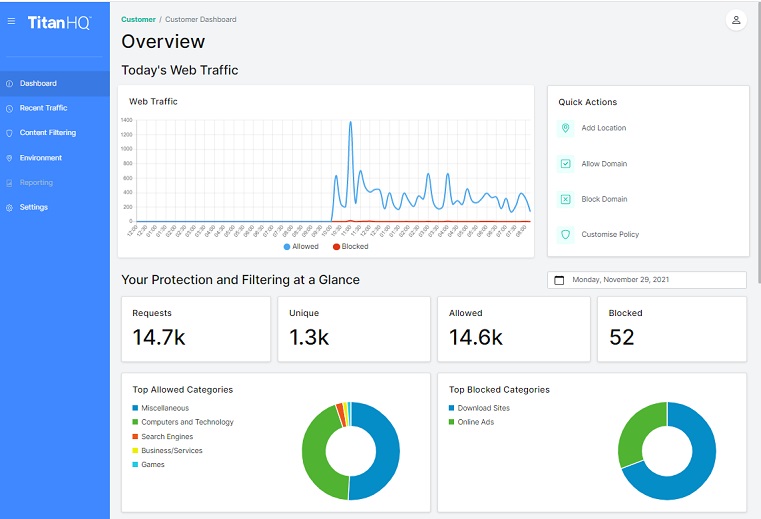What is content filtering? Why have filter lists become a threat?
Ever wonder how different organizations, companies, or even parents manage to control what the regular user or child can see on their devices and limit different websites? Well, all of this is possible through content filtering and filter lists. Content filtering is a process used to protect users from potentially harmful or offensive content on the web by controlling the type of material their users can access. This process allows users to remain safe and secure while surfing the internet. However, content filtering does not come without its risks. With the ever-evolving nature of the internet, content filtering can become outdated, leaving users vulnerable to malicious content and activities. As a result, it is important to understand the risks associated with content filtering and how to ensure that your content filtering is as up-to-date as possible.
How does it work?
Content filtering refers to the process of restricting or controlling access to certain types of online content, usually through the use of filter lists. Filter lists are sets of rules or criteria that determine what content is allowed or blocked by a particular filtering system. These lists can be created and maintained by individuals, organizations, or companies and are often used to block content deemed inappropriate or harmful, such as adult material, gambling websites, or malicious software. Filter lists can also block specific images and videos through keywords.

The main idea of how content filtering works is using a combination of software and hardware. The software scans the content of websites and other online sources and compares it against predetermined rules. The hardware then blocks the content that does not meet the criteria. These predefined rules can be applied to computers, networks, and mobile devices. That is why content filtering is considered a powerful tool for keeping users safe online. It can protect children from inappropriate content, prevent employees from accessing certain websites, and even block malicious content from reaching users, such as phishing scams, malware and viruses.
Benefits of predefined filter lists
As we mentioned above, content filtering can lead to significant benefits regarding children’s safety and help organizations and companies control and manage different incoming threats. This filtering process can also help organizations comply with laws and regulations. For example, it can be used to block websites that are restricted by specific laws and regulations, such as gambling and pornography websites. Content filtering can also prevent users from accessing sites that could put the organization at risk, such as websites that contain confidential information. By blocking inappropriate or malicious content, organizations can also reduce the amount of time spent dealing with security incidents. This can reduce the overall cost of dealing with security incidents and the cost of repairing any damage caused by malicious content.

Risks that come from filter lists
While content filtering and filter lists can be useful tools for managing online content and protecting against potential risks, they can also pose certain dangers. An obvious risk is that content filtering needs to be updated. As the internet evolves, new websites are created, new threats emerge, and the content on existing sites can change. Content filtering must be kept up-to-date to ensure users can avoid malicious content and activities.
Another potential risk is that filter lists can be overly broad or inaccurate, unintentionally blocking legitimate content. This can be particularly problematic for educational or research purposes and for those who rely on certain types of content for their work or personal interests. This can lead to a loss of productivity, as users cannot access certain websites or content necessary for their work. In a survey conducted in 2017, analysts from Bridge by Infrastructure surveyed 1,000 American workers. They found that workers watched an average of 77 minutes of non-work video content daily. Around 80% of employees use social media at work. That adds up to a lot of wasted hours and lost productivity.
Another common risk of content filtering is that it can be used to censor or control information by governments or other entities seeking to restrict access to certain ideas or viewpoints. This can have serious implications for freedom of expression and access to information and can limit the ability of individuals to engage in critical thinking and informed decision-making.
Finally, content filtering can be easily circumvented. If users are aware of the content filtering rules, they can easily find ways to bypass them. This can result in users accessing inappropriate or malicious content, putting themselves and their organizations at risk.

Best practices for content filtering
Individuals and organizations must implement content filtering to safeguard themselves and their users from online threats such as malware, phishing, and inappropriate content. One of the best practices for content filtering is establishing a clear policy that defines what type of content is acceptable and what is not. This policy should be communicated clearly to all users and enforced consistently. Additionally, a multi-layered approach to content filtering should be employed, using various filters such as URL filtering, DNS filtering, and application filtering. Known malicious websites and other online threats should be blocked using a blacklist that is regularly updated, while legitimate business or educational purposes should be allowed for exceptions. Also, regularly monitoring user activity can detect and prevent attempts to bypass content filtering.
Various filter list rules can be applied, including blocking access to known malicious sites, inappropriate content, social media sites, gambling sites, and file-sharing sites. However, it’s essential to customize these rules to fit the organisation’s or individual’s needs and regularly review and update them to ensure their effectiveness.
All in all, content filtering is a critical process that involves identifying and blocking access to inappropriate or harmful content on the internet. Therefore, it’s crucial to establish a clear content filtering policy, employ a multi-layered approach, regularly monitor user activity, and educate users on the importance of content filtering. Customized filter list rules, such as blocking access to malicious sites, inappropriate content, social media sites, gambling sites, and file-sharing sites, can be used to improve the effectiveness of content filtering. But remember, always keep them up-to-date to avoid and prevent outdated filter lists that can lead to severe malicious threats.

![November 18 Advisory: Windows KDC Proxy Remote Code Execution Vulnerability [CVE-2024-43639]](https://4imag.com/wp-content/uploads/2024/11/christin-hume-hBuwVLcYTnA-unsplash-760x500.jpg)

